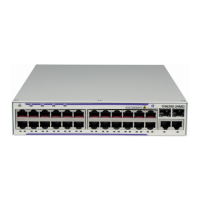MPLS Commands
Page 134 7210 SAS M, T, X, R6, Mxp MPLS Configuration
Guide
shutdown
Syntax [no] shutdown
Context config>router>mpls>mpls-tp>transit-path
Description Platforms Supported: 7210 SAS-T network mode and 7210 SAS-R6 devices.
This command administratively enables or disables an MPLS-TP transit path.
Default no shutdown

